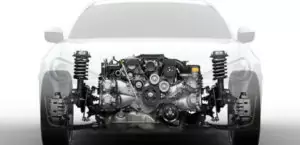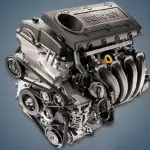The Hyundai-Kia G4KH 2.0-liter turbo engine or 2.0 Turbo GDi has been produced since 2010 and is installed on charged versions of such models as Sonata, Optima, Sorento and Sportage. There is a version of this unit for a longitudinal arrangement with its index G4KL.
In 2010, the American versions of the Sonata and Optima sedans, as well as the Sportage 3 crossover, debuted a 2.0-liter Theta II turbo engine with GDi type direct fuel injection. By design, it is quite typical for the series, it has an aluminum block with cast-iron liners, a 16-valve cylinder head without hydraulic lifters, a Dual CVVT phase control system on both shafts, a timing chain drive and a balancer shaft block combined in one housing with an oil pump.
The first generation of these engines was equipped with a Mitsubishi TD04HL4S‑19T‑8.5 turbocharger, had a compression ratio of 9.5 and developed 260 – 280 hp and 365 Nm of torque. The second generation appeared in 2015 and featured an E-CVVT intake phase shifter, a compression ratio of 10, and a slightly simpler Mitsubishi TD04L6‑13WDT‑7.0T turbocharger. The power of such a unit has decreased to 240 – 250 hp and 353 Nm of torque.
Theta 2.0L family: G4KA, G4KD, G4KF, G4KH, G4KL.
The engine was installed on:
- Hyundai Santa Fe 3 (DM) in 2012 – 2018; Santa Fe 4 (TM) in 2018 – 2020;
- Hyundai Sonata 6 (YF) in 2010 – 2015; Sonata 7 (LF) in 2014 – 2020;
- Hyundai i30 3 (PD) in 2018 – 2020;
- Hyundai Veloster 2 (JS) in 2018 – 2020;
- Kia Optima 3 (TF) in 2010 – 2015; Optima 4 (JF) in 2015 – 2020;
- Kia Sportage 3 (SL) in 2010 – 2015; Sportage 4 (QL) in 2015 – 2021;
- Kia Sorento 3 (UM) in 2014 – 2020.
Specifications
| Production years | since 2010 |
| Displacement, cc | 1998 |
| Fuel system | direct injection |
| Power output, hp | 240 – 280 |
| Torque output, Nm | 353 – 365 |
| Cylinder block | aluminum R4 |
| Block head | aluminum 16v |
| Cylinder bore, mm | 86 |
| Piston stroke, mm | 86 |
| Compression ratio | 9.5 – 10.0 |
| Hydraulic lifters | no |
| Timing drive | chain |
| Phase regulator | Dual CVVT |
| Turbocharging | yes |
| Recommended engine oil | 5W-20, 5W-30 |
| Engine oil capacity, liter | 6.1 |
| Fuel type | petrol |
| Euro standards | EURO 5/6 |
| Fuel consumption, L/100 km (for Kia Optima 2017) — city — highway — combined |
12.5 6.3 8.5 |
| Engine lifespan, km | ~200 000 |
| Weight, kg | 135.5 |
Disadvantages of the Hyundai G4KH engine
- These turbo engines are very demanding on the quality of the oil and the procedure for replacing it, otherwise the risk of cranking the liners on a run of about 100 thousand kilometers is extremely high. Even in car services, they sin on an unsuccessful block of balancers combined with an oil pump: due to the rapid wear of its liners, the pressure in the engine lubrication system decreases.
- The second generation units were recalled as part of a campaign to replace the E-CVVT phase regulator. The problem was most often solved by installing a new cover, but in advanced cases it was necessary to change the entire assembly.
- The units of the first generation did not have oil nozzles and they have scuffs, but most often the cause of oil consumption here is the banal ellipse of the cylinders. The rigidity of the aluminum block is low and it quickly leads to overheating.
- As in any engine with direct injection, the intake valves quickly overgrow with soot. The timing chain also serves relatively little, the temperature sensor often fails, various air pipes constantly burst and oil leaks through the oil seals occur.







What is the difference between the version installed on sonata yf and lf.